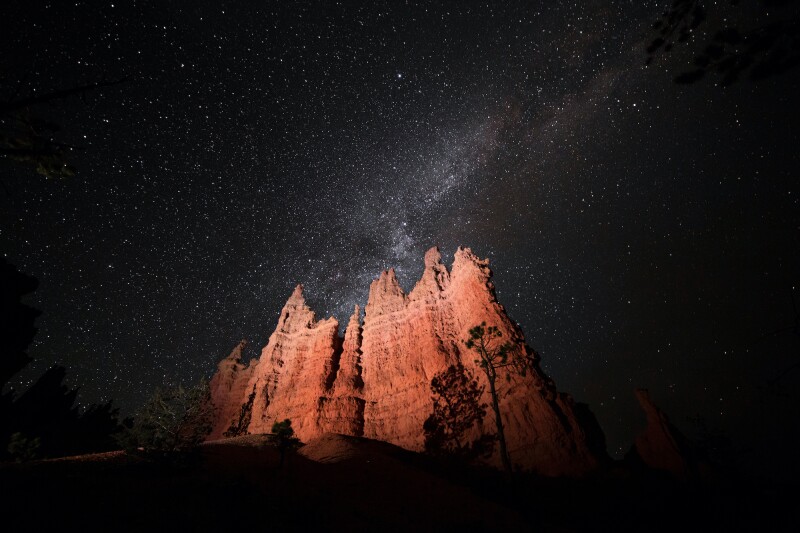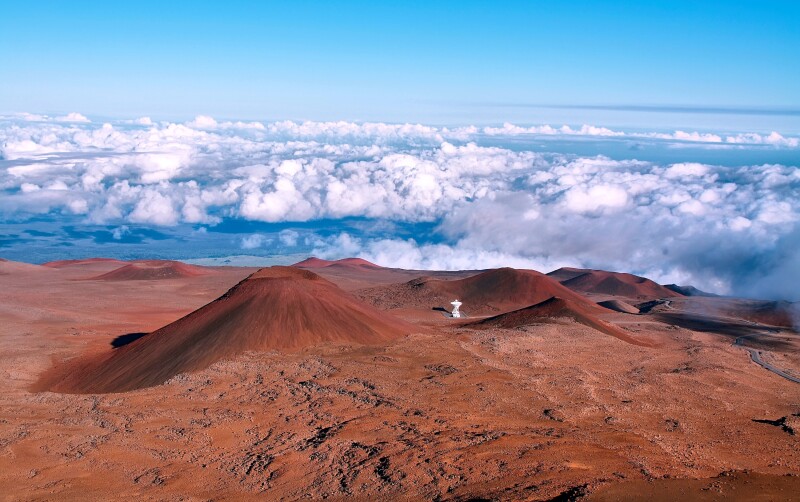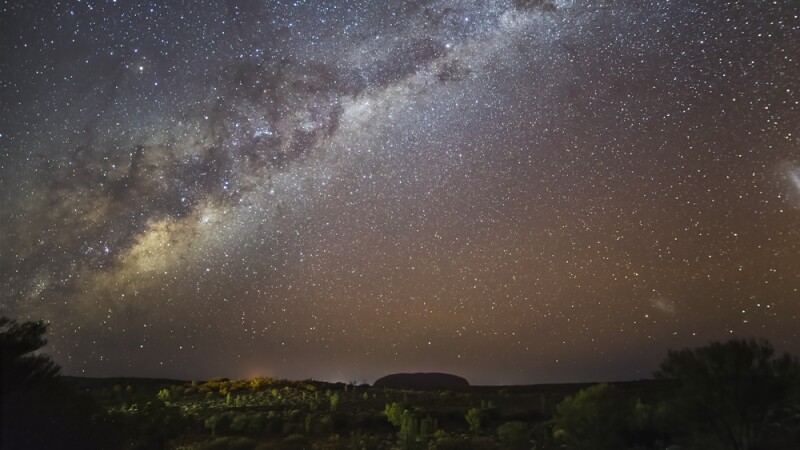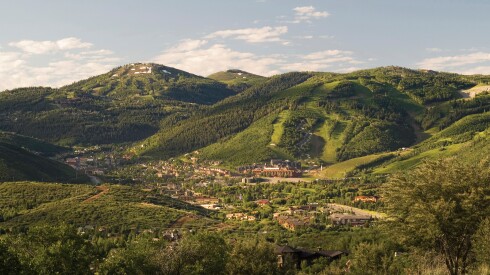There’s nothing quite like looking up into an expansive night sky dotted with stars, planets, and constellations. But ultra-dark skies where you can actually see these are far too rare. That’s where DarkSky comes in. It was founded in 1988 as the International Dark-Sky Association and works to protect places from light pollution and recognize those—now more than 200—that preserve the planet’s darkest, most star-filled skies. UNESCO also recognizes a number of certified Starlight Reserves on its list of Astronomical Heritage sites.
These spectacular stargazing spots offer visitors opportunities to learn more about the universe and reconnect with the incredible planet we all call home. From Utah to Namibia, here are 16 of the world’s best places for stargazing.
1. NamibRand Nature Reserve, Namibia
The NamibRand Nature Reserve lies in what DarkSky calls “one of the naturally darkest (yet accessible) places on Earth,” because the closest inhabited communities are at least 60 miles from its location. The nearly 500,000-acre stretch of land in southwestern Namibia is protected by the Namib Desert Environmental Education Trust (NaDEET) Center, which runs educational environmental programs in the area (mostly for local students). Visitors seeking the NamibRand Nature Reserve stargazing experience should check out the Wolwedans camps and lodges, where travelers can book a sustainably focused overnight stay in the starry-skied desert.

Bryce Canyon is one of 15 certified Dark Sky Places in Utah, among them Rainbow Bridge National Monument, Canyonlands National Park, and Arches National Park.
Photo by sixfournorth/Shutterstock
2. Bryce Canyon National Park, Utah
One of many national parks in the southwestern United States, Bryce Canyon is particularly noteworthy for its surreal-looking hoodoo rock formations and its especially starry night skies. The more than 35,000-acre national park is slightly less crowded than the nearby Grand Canyon (also an International Dark Sky Park), so you’ll have more elbow room for stargazing and during any astronomy programs. On excursions led by the park’s astronomy rangers, visitors can check out thousands of stars, see a horizon-to-horizon view of the Milky Way, and glimpse both Venus and Jupiter.

Aoraki Mackenzie International Dark Sky Reserve’s dark-sky heritage is associated with the indigenous Māori people, who have long practiced celestial navigation and integrated astronomy into their traditions.
Photo by Matt Makes Photos/Shutterstock
2. Aoraki Mackenzie International Dark Sky Reserve, New Zealand
New Zealand’s Aoraki Mackenzie International Dark Sky Reserve was established in 2012 to recognize the incredible stargazing opportunities in the Mackenzie Basin on the South Island. This is one of only 22 Dark Sky Reserves worldwide; visitors come for the reserve’s planetarium, telescope areas, and observatories, where guided tours are offered at the Lake Tekapo Earth and Sky and Aoraki/Mount Cook visitor centers. On clear nights in the reserve, it’s often possible to see the aurora australis, the Southern Cross, and the Southern Star—all with the park’s namesake peak (reaching more than 12,000 feet) in the background.

Swim in the surprisingly warm Atlantic by day before layering up to stargaze.
Photo by Gregorioa/Shutterstock
4. La Palma and Tenerife, Canary Islands
The Canary Islands are home to three UNESCO-recognized “Starlight Reserves” designated by the nonprofit Starlight Foundation. The starry night sky can be viewed clearly from across the Atlantic Ocean archipelago, but both professional and amateur astronomers are typically directed to La Palma and Tenerife for the booming astro-tourism industry. These two islands are home to three observatory areas set up by the Tenerife-based Instituto de Astrofísica de Canarias. Some of the best places to stargaze on these islands include atop Garajonay Summit and San Bartolo Mountain (La Palma) and El Palmar viewpoint and Guajara Mountain (Tenerife). Although the islands are warm to hot at sea level, it’s much cooler at elevation, so be sure to bring some warm clothing.

The base of Hawaii’s Mauna Kea begins 19,704 feet below the water’s surface.
Photo by Marisa Estivill/Shutterstock
5. Mauna Kea, Hawai‘i
Located on the Big Island, dormant volcano Mauna Kea offers both the highest peak in Hawai‘i as well as the best stargazing opportunities in the region. About halfway up Mauna Kea, which reaches nearly 14,000 feet above sea level, the Onizuka Center for International Astronomy Visitor Information Station offers a stargazing program for visitors. From there, stargazers can continue to the volcano’s summit with their own four-wheel-drive vehicle or as part of a guided excursion. (Still, it’s advised that travelers pause at the midway point to acclimatize to the dramatic change in elevation. Be sure, also, to pack warm clothing; it’s much colder than at sea level.)

Situated in Nepal’s northeastern Himalayas, the extremely remote Sagarmatha National Park offers world-class stargazing.
Photo by Raisa Suprun/Shutterstock
6. Sagarmatha National Park, Nepal
This UNESCO World Heritage site is widely known to travelers for a reason other than its stargazing; Sagarmatha National Park in Nepal is also home to the world’s highest peak, Mount Everest. But visitors don’t need to be ready to trek the slopes of this not-so-gentle giant to get a memorable experience. The national park includes a series of hiking trails on slightly more approachable mountain peaks as well as a lower-altitude forested zone, where adventurers can view towering Mount Everest surrounded by a broad night sky and a smattering of bright stars.

Ireland’s Kerry International Dark-Sky Reserve is one of the world’s four Gold Tier Dark Sky Reserves designated by IDA.
Photo by Stephen Power/Shutterstock
7. Kerry International Dark Sky Reserve, Ireland
The Kerry International Dark Sky Reserve occupies the southwest area of Ireland on the Iveragh Peninsula and along the Wild Atlantic Way. At night, this land between the Kerry Mountains and Atlantic Ocean offers a breathtaking dark and starry sky undisturbed by the nine inhabited villages within its perimeter. Guests to this remote part of Ireland can stay at a number of locally owned properties around the reserve.

The aurora borealis above Denali National Park
Photo by Shutterstock
8. Denali National Park Reserve, Alaska
This 6-million-acre preserve of land in Alaska is home to a slew of native wildlife, such as grizzly bears and caribou, as well as Denali, the highest summit in North America. Far removed from light and noise pollution, the unspoiled landscape within Denali National Park has exceptional stargazing. Stars, planets, and even the aurora borealis (northern lights) are visible in the dark night sky throughout most of the year. For optimum stargazing, it’s best to come anytime except summer (when the days are long).

Low rainfall, high altitude, and little light pollution make northern Chile’s greater Atacama–Elqui region an optimal spot for stargazing.
Photo by Shutterstock
9. Atacama Desert and Elqui Valley, Chile
Low rainfall, high altitude, and scant light pollution in Chile’s greater Atacama–Elqui region make it a go-to destination for astro-tourism. The 90,000-acre Elqui Valley, also known for its wine production, became the first-ever International Dark Sky Sanctuary in 2015. (It’s named the Gabriela Mistral Dark Sky Sanctuary in honor of the 20th-century Nobel Prize–winning poet Gabriela Mistral, who spent her childhood in the Chilean region.) About five hours north of the Elqui Valley, the tourist-friendly town of San Pedro de Atacama offers a mix of budget hostels and luxury accommodations in the Atacama Desert, such as the sustainable Explora Atacama Lodge.

Milky Way over Uluru
Photo by Shutterstock
10. Uluru, Australia
The Sounds of Silence tour (US$175 per adult for a four-hour tour, including dinner and drinks) at Ayers Rock Resort begins at sunset when the iconic rock formations of Uluru and Kata Tjuta glow fiery red. After a short walk through the dunes to a panoramic viewpoint, participants settle at their tables to dine outdoors on Aussie fare. When night falls, one of the resort’s resident star talkers directs diners to sights in the southern sky and explains the stars’ significance in the culture of Uluru’s traditional landowners, the Aboriginal Anangu people. The resort also offers a family-friendly Outback Sky Tour (US$41 per adult), which takes groups out for a one-hour stargazing excursion.
11. Great Sand Dunes National Park and Preserve, Colorado
Sculpted by the winds of time, the golden-hued slopes found at this lesser-known national park in southern Colorado are among the tallest sand dunes in North America. This quiet corner of the state sees little light pollution and mostly cloudless nights, making spotting the Milky Way from any part of the park easy. Be sure to check out what free ranger programs are being offered—many of the events celebrate and educate on the stars above.
12. Death Valley National Park, California and Nevada
Any place that throws an annual dark sky festival in collaboration with NASA is bound to be celestially superior. Here, 282 feet below sea level—the lowest elevation in North America—is a vast desert landscape that makes for an extraordinary place for night exploration.
Throughout the summer, rangers lead talks and presentations on preserving and appreciating the night sky. They also make recommendations for astrophotographers to capture the night sky (places such as Zabriskie Point, Mesquite Flat Sand Dunes, or Harmony Borax Works). And for visitors keen on extending their trip, the rangers suggest checking out the Park to Park in the Dark route, which connects Death Valley and Great Basin National Park.

It’s possible to see the Milky Way on a clear night in Great Basin National Park, Nevada.
Photo by Asif Islam/Shutterstock
13. Great Basin National Park, Nevada
Situated between two mammoth mountain ranges (the Sierra Nevada in California and the Wasatch Mountains of Utah), Great Basin National Park is shielded from the light pollution of most cities. It’s also one of the most remote national parks in the Lower 48, making it challenging to visit. However, each summer, the Nevada Northern Railway company in Ely, Nevada, offers a weekly Star Train; travelers can board the train with rangers from the park to chug into the reserve to learn about the heavens. The train is super popular, so book tickets far in advance.

From Boundary Waters, travelers can sometimes see the northern lights.
Photo by Shutterstock
14. Boundary Waters Canoe Area Wilderness, Minnesota
Spanning more than 1 million acres across northeastern Minnesota, this wilderness area was better known for paddling and fishing in glacial lakes and streams and hiking in forests and rocky cliffs—all daytime activities—until it was named a Dark Sky Sanctuary in 2020. Here sky gazers can see the Milky Way; Mercury, Venus, Mars, Jupiter, and Saturn (all without a telescope); various constellations and, in the winter, the northern lights.

Thanks to its remote location, Big Bend National Park offers some of the darkest skies in the lower 48.
Photo by Wisanu Boonrawd/Shutterstock
15. Greater Big Bend International Dark Sky Reserve, Texas and Mexico
At 9 million acres, this is one of the largest protected dark-sky areas on Earth, straddling the border of southwestern Texas and northern Mexico. While the reserve’s name only refers to Big Bend National Park, it also includes Big Bend Ranch State Park and Black Gap Wildlife Management Area in Texas, as well as three protected areas in Mexico—Maderas del Carmen, Ocampo, and Cañón de Santa Elena. It’s the world’s first binational International Dark Sky Reserve.
Here, the Milky Way casts a dazzling, dappled glow across the sky’s inky canvas, and visitors can join guided night sky programs led by park rangers to understand better the cosmos and the importance of preserving natural darkness. It’s also possible to visit the McDonald Observatory in Fort Davis, Texas, for a deeper dive into the galaxy.

In Wadi Rum, visitors can literally sleep under the stars.
Photo by kasakphoto/Shutterstock
16. Wadi Rum, Jordan
The otherworldly rock formations and red desert landscape of this nearly 185,000-acre protected area have been featured in movies like Dune and The Martian, but this desert shines best at night. Travel to this remote part of southern Jordan and you can see the Milky Way with your naked eye; Wadi Rum’s extreme isolation makes this an ideal place to take in the full expanse of the stars above. Spend the night at a Bedouin camp and you can learn not only about the stars but also about Bedouin customs and the realities of desert living.
This article was originally published in 2017 and most recently updated on December 27, 2024, to include current information. Bailey Berg coauthored this article.











